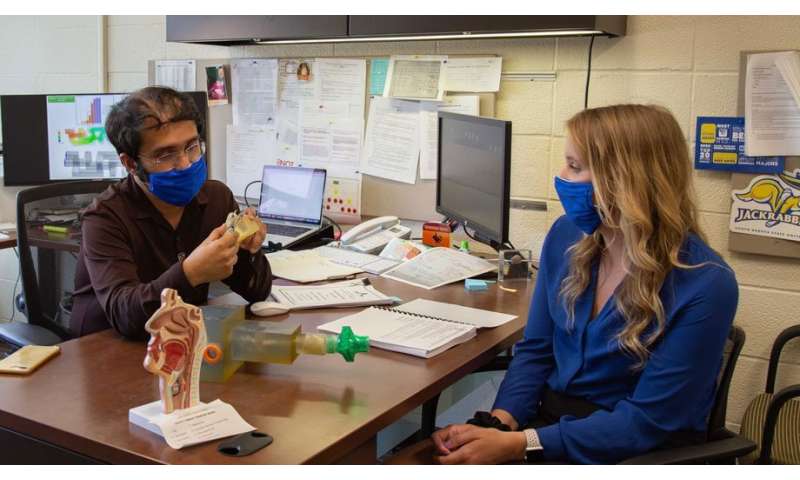Masks can block coronavirus-carrying droplets

If you are exposed to the new coronavirus, how likely are you to become infected?
How many virus particles you inhale and where they land within the respiratory tract can affect your chances of contracting COVID-19, according to assistant professor Saikat Basu of South Dakota State University’s Department of Mechanical Engineering.
“To become infected, you must first inhale the virus, so inhalation patterns are important,” said Basu. He has developed a model that uses breathing rates to track the droplet sizes that are likely to reach the most vulnerable area of the respiratory tract. The modeling is part of a multi-institution National Science Foundation-funded research project to develop a mask with a reusable respirator that captures and kills the novel coronavirus.
The good news is masks worn over the nose have the potential to block the droplet sizes that are most likely to reach the initial infection site. The bad news is the virus-carrying droplets that COVID-19 carriers expel dehydrate in the air, increasing their disease-causing potential.
“The droplets being inhaled after dehydration in the external air carry a larger viral load,” Basu explained. In lieu of this, the higher relative humidity in countries such as Brazil and India may have been advantageous this summer.
The results from the droplet inhalation modeling have been screened by the scientific team at medRxiv, the preprint server for health sciences, and are available online. The corresponding research manuscript is also currently undergoing peer review at PLOS One, an open access scientific journal. SDSU’s high-performance computing cluster was used for part of the aerosol modeling.
Droplets entering through nose
A University of North Carolina Chapel Hill cell culture study showed that the upper part of the throat behind the nasal passages and above the esophagus and voice box, known as the nasopharynx, serves as the most accessible seeding zone, Basu explained. Other studies, including one at Oxford University, have confirmed this.
“The mucous layer in the anterior nasal passages makes it more difficult for the virus to infect these cells,” Basu noted. Furthermore, the ciliated cells that line the nasopharynx located behind the anterior nasal cavity have a surface receptor, known as ACE2, which the virus uses to enter the cells. The infection then spreads from this initial infection site into the lungs through aspiration of the virus-laden nasopharyngeal fluids.
To determine which droplet sizes are most likely to reach the nasopharynx, Basu developed CT-based digital models of the nasal airspace of two healthy adults and simulated four inhalation rates—15, 30, 55 and 85 liters per minute.
“The 15-liter rate happens while sitting still and gently breathing and 30 would roughly correspond to your breathing rate while walking,” he explained. Sniffing and breathing in forcefully fall within the range of 60 to 75 liters per minute.
“When viral transmission is averaged over different breathing rates, droplets ranging from 2.5 to 19 microns in size do the best job of landing at the nasopharynx,” he noted. These droplets sizes are larger than expected.
“Most masks would block out these droplet sizes, so wearing a mask is very useful,” Basu said. “These are also the droplet sizes that we need to make sure our new respirator design captures.”
In addition, this data will be useful in developing inhaled antiviral therapeutics and targeted intranasal vaccines that reach this initial infection site.
Condensation increasing viral load
Based on the reports related to the Skagit Valley choral group in which one person transmitted COVID-19 to 52 of the 61 choir members, Basu derived a conservative estimate of around 300 virus particles, or virions, as the threshold for infection.
“The fact that the number of virus particles needed to launch the infection is in the range of hundreds is very remarkable and shows how contagious this particular virus is,” Basu said. Typically, an inhaled viral infection, such as influenza, requires 1,950 to 3,000 virions.
To estimate the probability that a droplet will contain at least one virion, Basu used a study on the amount of virus in the sputum and mucus of COVID-19 patients and then accounted for environment-induced dehydration.
A predicted one-third reduction in droplet size means the likelihood that a 10-micron droplet will contain at least one virion increases from 0.37% to 13.6%, he explained. For a 15-micron droplet, that probability increases to 45.8%. This happens because the constituents in the virus-containing droplets are non-volatile. When these constituents evaporate, the concentration of virus particles in the droplets elevates significantly.
Source: Read Full Article
